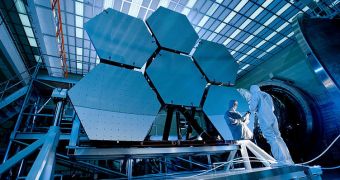As the American space agency is continuing to develop the most advanced telescope the world has ever seen, some interesting things about the instrument are beginning to pop up. One of them is the fact that its sunshield provides the best Sun Protection Factor (SPF) in the Universe.
The most important thing about the James Webb Space Telescope (JWST) is that it's the largest and most complex ever constructed. Its heat shield alone is the size of a tennis court, which is saying a lot.
Due to the complex nature of its instruments, the observatory will need to be placed in an orbital point that will prevent any stray light from entering its detectors. Experts at NASA opted for the L2 Lagrangian point.
Once it arrives at this location, the telescope will remain in the same relative position in regards to the Sun-Earth-Moon system. Its heatshield will be facing these three objects, so as to prevent any light from hindering JWST's observations of the early moments of the Cosmos.
According to the shield's fact sheet, the defense mechanism will have a SPF of 1,000,000. “Each of the five layers of the shield is less than half the thickness of a piece of paper,” says John Durning.
“The five work together to create an effective SPF of 1,000,000,” explains the expert, who is the deputy project manager for the telescope. In addition to providing protection from sunlight, the shield will also play a part in cooling the observatory down.
One of the things that posed a challenge to designers was transporting the heat shield to the L2 point. Given its size, it cannot be transported in its final configuration, and therefore needs to be folded.
The JWST will feature two Mid Boom Assemblies (MBA), which are basically deployable towers to which the heatshield is attached. As they unfold, they will pull the protective device into position.
This operation is scheduled to last for about 7 minutes, and will begin as soon as the telescope arrives at its final point, some 1.5 million kilometers (1 million miles) away from Earth. There are five Lagrangian points surrounding our planet at various distances.
Durning explains that the shield is made up of a material called Kapton, which is film-like in appearance, but extremely efficient at shielding against visible-light and ultraviolet radiation.
It was fashioned into five layers, each of them measuring 20 meters (65.6 feet) by 12 meters (39.3 feet). Its designers say the material can operate in temperatures ranging from 36 to 650 degrees Kelvin (-395 to 710 degrees Fahrenheit, or -237 to 377 degrees Celsius).
JWST's primary mission is to replace the NASA Hubble Space Telescope, which is more than 20 years old, and also to extend astronomers' ability to peer back into the early history of the Universe.
Its sensitive detectors were created so that they can pick up the faintest glow of the earliest stars and galaxies that ever developed, Universe Today reports.

 14 DAY TRIAL //
14 DAY TRIAL //